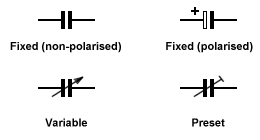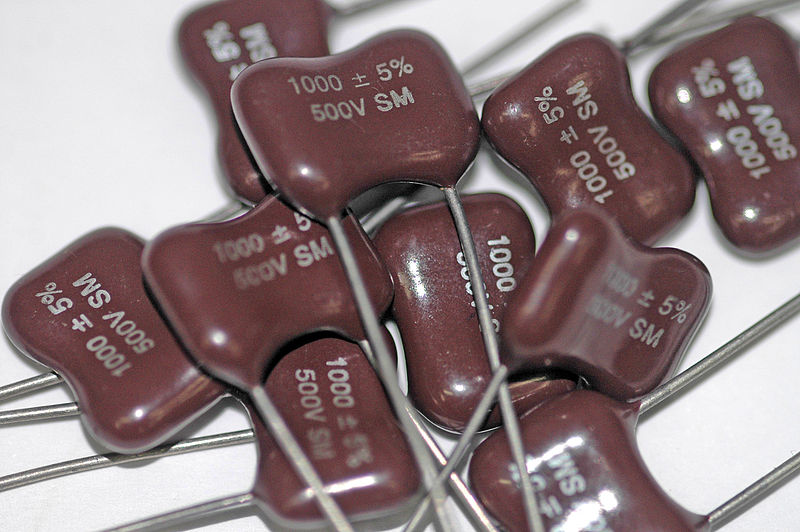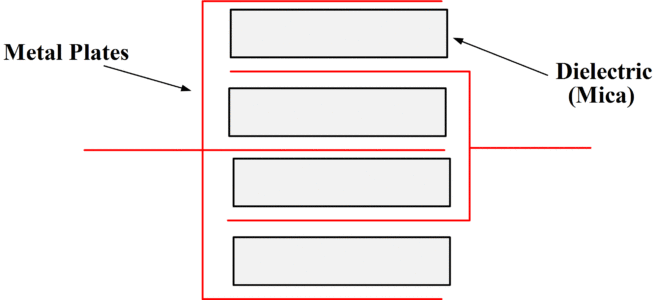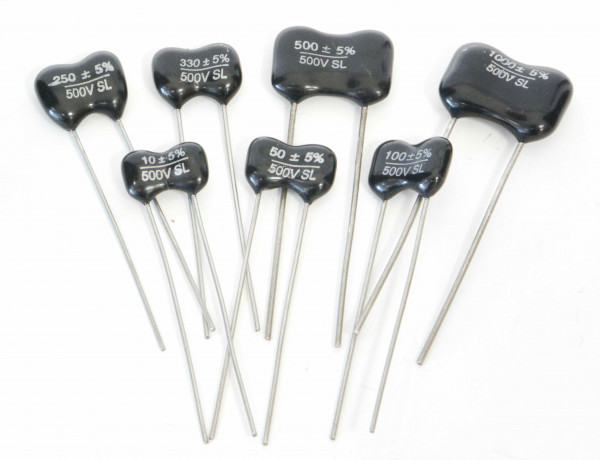What is Mica Capacitors: Mica is one of the natural minerals. Silver mica capacitors are types of capacitors that use mica as the dielectric. There are two varieties of mica capacitors: silver mica capacitors and clamped mica capacitors. Clamped mica capacitors are regarded as obsolete due to their inferior characteristics. Silver mica capacitors are used alternatively.
They are produced by sandwiching mica layers coated with metal on both sides. This construction is then encased in epoxy to protect it from the surrounding area. Mica capacitors are frequently used when stable, reliable capacitors of comparatively small values are required. These types are low-loss capacitors, making them a good choice at high frequencies, and their properties do not change much over time.
Mica minerals are very chemically, electrically, and mechanically stable. Due to its specific crystalline structure binding, it has a characteristic layered structure. This makes it possible to form thin sheets in the order of 0.025-0.125 mm. The most regularly used mica types are muscovite and phlogopite.
The first has more excellent electrical properties, while the second has a greater temperature resistance. Mica is delved in Central Africa, India, and South America. The high variation in material composition leads to the high cost needed for sorting and inspection. Mica does not have reactions with most acids, oil, water, and solvents.
What are Capacitors?
A capacitor is a piece of electronic equipment that stores charge. It also prevents the direct current flow in a circuit while permitting the alternating current flow. The most simplistic form of the capacitor has two parallel conducting plates divided by a non-conducting (dielectric) material. The orientation of the capacitor depends on the type of dielectric used in a circuit.
In a polarised capacitor, current enters the capacitor via its positive terminal, while for a non-polarised capacitor, current may enter the capacitor through both terminals. The structure of a primary capacitor is shown here with the circuit diagram symbols used for different types of capacitors.

The strength of a capacitor to store charge is associated with its capacitance C, which is measured in farads. A farad is a capacitance at which one coulomb is deposited for a potential difference of one volt. All the capacitors in electronic circuits have a very small capacitance value (sometimes minuscule), so the micro, nano and picofarad are often used when addressing the value of a capacitor:
Typical capacitance ranges from 1 picofarad up to roughly 0.15 farads. The capacitance of a capacitor is based on the area of the conducting plates (the wider the area, the higher the capacitance), the gap between the plates (the capacitance is inversely proportional) and the permittivity of the dielectric substance between the plates. The capacitor searching for a specific application depends on the acceptable tolerance, the capacitance required, and the degree of stability required. Two additional factors are also relevant:
- Working voltage_ this factor is the largest potential difference (DC or peak AC) that can securely be applied across the capacitor and is usually stamped on the capacitor. If the working voltage is significantly surpassed, the dielectric will break down and permanent destruction to the capacitor may befall.
- Leakage current_ As no dielectric is a pure insulator, there will always be some loss of charge during a time. This loss charge is called the leakage current. The amount of this leakage should be as small as it can.

What is Mica Capacitor?
Silver mica capacitors were developed from the very early mica capacitors used in the early 1920s and 30s. The Dubilier company made these early mica capacitors and some of their Micadon capacitors can still be found in vintage radio sets.
These capacitors used to be made from mica sheets and copper foils sandwiched together and clamped. The clamps could often be noticed in the construction of the capacitor.
These old mica capacitors had insufficient levels of tolerance and stability resulting from the mica dielectric’s imperfect service, which was a generally occurring material. References to mica capacitors from the 1920s always refer to this type of mica capacitor.
The early mica capacitors were developed more, and their performance was significantly enhanced for the silver mica capacitors to be utilized more recently and even more popular today.
Silver Mica Capacitors
As the name implies, silver mica capacitors have a mica dielectric which is silvered to produce the electrodes or plates of the capacitor.
Mica is a shiny material from silicate minerals with a layered or monoclinic structure, which means that it can be easily split into thin plates.
The material has a relatively large dielectric constant compared to many other typically occurring layered minerals. It generally is between 5 and 7. Mica has a very stable mechanical and chemical properties making them a good choice for electronic capacitors. The chemical resistance and stability mean that the long term performance of the silver mica capacitor is outstanding.
Mica does not react with many acids, alkalis, solvents, oil, and water. As a result, we can not see ageing to any major degree. Also, the water vapour changes in the atmosphere do not make extreme variations in the overall capacitor function.
Natural mica has to be selected delicately because some samples include impurities that can deteriorate the performance of the silver mica capacitor. Also, the sheets of mica in the capacitor are relatively thin, ranging from 0.025 to 0.1 mm. There is a high level of variation in the raw material as it usually occurs. This ends in higher manufacturing costs as it requires precise inspection, sorting and manufacturing.
Although more expensive than other dielectrics, mica is the best form of dielectric for very high-performance capacitors. Dielectric constant of the mica is 6 while the dielectric strength is 10000 volts per mil.

Choosing the Right Silver Mica Capacitor
When we are picking the right mica capacitors, we should filter the various characteristic results to be able to find the right silver mica capacitors. The next factors should investigate before choosing this capacitor
- Capacitance available in the market: 2 pF, 22 pF, 47 pF, 100 pF, 470 pF
- Lead Spacing available in the market: 3.6 mm, 5.9 mm, 8.7 mm, 11.1 mm
- Rated Voltage varies from 50 V to 1 kV
What is Mica Capacitor Construction
The construction of a mica capacitor can be prepared by inserting metal coated mica films one over another on both sides. After that, all layers are covered in epoxy to protect them from the environment. Mica is an electrically, mechanically & chemically stable material due to the binding of its exact crystalline characteristic layered structure. The thin films of this capacitor can be fabricated with 0.025mm to 0.125 mm diameter.
The mica materials which are most commonly used are phlogopite and muscovite. The electrical qualities of muscovite are better, whereas the temperature resistance of phlogopite mica is high. Most of the dielectric materials like Mica are investigated in South America, India, and Central Africa. Mica materials do not have a chemical reaction with most oil, acids, solvents, and water.

Characteristics of Mica Capacitor
The reason for the extended use of silver mica capacitors is that they can offer extremely high-performance levels, better in many operations than any other type of capacitor. However, in many applications, other modern technologies present performance levels that meet that particular requirement. The specific properties of the mica capacitor are listed below:
Accuracy and Tolerance
The rate of smallest tolerance of a silver mica capacitor can reach as low as ±1%. This value is much preferred over almost all other varieties of capacitors. In contrast, positive ceramic type capacitors can have tolerances up to ±20%.
Stability
These mica capacitors are pretty constant and very precise. Their capacitance varies small over time. This is because there are no air spaces in the device that might change over time. Also, the assembly is guarded against other issues by an epoxy resin. It means that external impacts similar to air humidity do not affect mica capacitors. Not only is their capacitance steady over time, it is also constant over an extended voltage, frequency and temperature range. The standard temperature coefficient is approximately 50 ppm/°C.
High Q
Silver mica capacitors have very high levels of Q and small power factors. These are both relatively independent of frequency. This is a feature of the capacitors useful in building stable low noise oscillators, and selective filters.
Temperature Coefficient
Silver mica capacitors have a much better temperature coefficient compared to most other types of capacitors. The value of the temperature coefficient is positive and usually is in the range of 35 to 75 ppm / C, with an average value of +50 ppm / C being. This property is useful in securing oscillators (and filters) that do not drift with temperature.
Value Range
Capacity for silver mica capacitors normally range between a few picofarads up to two or maybe three thousand picofarads.
Low Losses
These capacitors have low resistive and inductive losses. The properties of these capacitors are usually frequency independent, which allows for their use in high frequency. These more desirable qualities come at a price: silver mica capacitors are costly and large.

Advantages and Disadvantages of Mica Capacitors
The advantages and disadvantages of mica capacitors are as the following :
Advantages of mica capacitors:
- Operates at high temperatures
- Stable capacitance
- Withstand at very high voltages
- Low losses
- Dielectric provides good insulation
- Highly accurate
Disadvantages of mica capacitors:
Although the silver mica capacitor has a high tolerance and low-temperature coefficient, we can see jumps in value on some occasions. When this happens, it can cause a filter to change its properties or an oscillator to jump in frequency. Other disadvantages are:
- High cost
- Proper sealing is required
Silver Mica Capacitor Applications
Silver mica capacitors can provide very high levels of stability, accuracy and low loss. As a result, silver mica capacitors have many applications, in particular for radiofrequency purposes:
- Filters: The relative tolerance levels of the silver mica capacitor permits the actual performance to be predicted and calculated. Also, the low loss degree of the silver mica capacitor allows high Q filters to be realized.
- RF oscillators: Silver mica capacitors can support applications within RF oscillators. In these devices, their low loss levels qualify the Q of the tuned circuit to be improved. This yields increased stability and decreased phase noise levels. Also, their low-temperature coefficient lets even free-running oscillators obtain good stability levels and less drift.
- Coupling and decoupling: The price of silver mica capacitors usually means that they are not accepted for coupling and decoupling, but they can resist high voltages, and this may have indicated that they have been used for these purposes occasionally. We can use them in amplifiers and RF transmitters where their high voltage capability is used as cost-effective porcelain or ceramic capacitors are not broadly available.
Buy Equipment or Ask for a Service
By using Linquip RFQ Service, you can expect to receive quotations from various suppliers across multiple industries and regions.
Click Here to Request a Quotation From Suppliers and Service Providers
Read More In Linquip
-
- What is a Non-Polarized Capacitor? Types & Function
- Difference between Capacitor and Inductor- Capacitor vs. Inductor
- What is a Paper Capacitor?
- What is Mica Capacitor Used for?
- What is Electrolytic Capacitor? Usage & Application
- What is Film Capacitor & What is it used for?
- What is Capacitor and How Does it Work?
- 7 Types of Capacitors and Their Uses
- What is Ceramic Capacitor Used for?
- What is Electrolytic Capacitor?
- What is Film Capacitor? Different Types & Working
- What is Ceramic Capacitor? A Basic Description
- Types of Capacitors: All You Need to Know
- Difference Between Condenser and Capacitor in a nutshell 2022




Can or should an electrolytic cap change values or have a reactance when top section”metal” is touched with finger to chassis ground,??